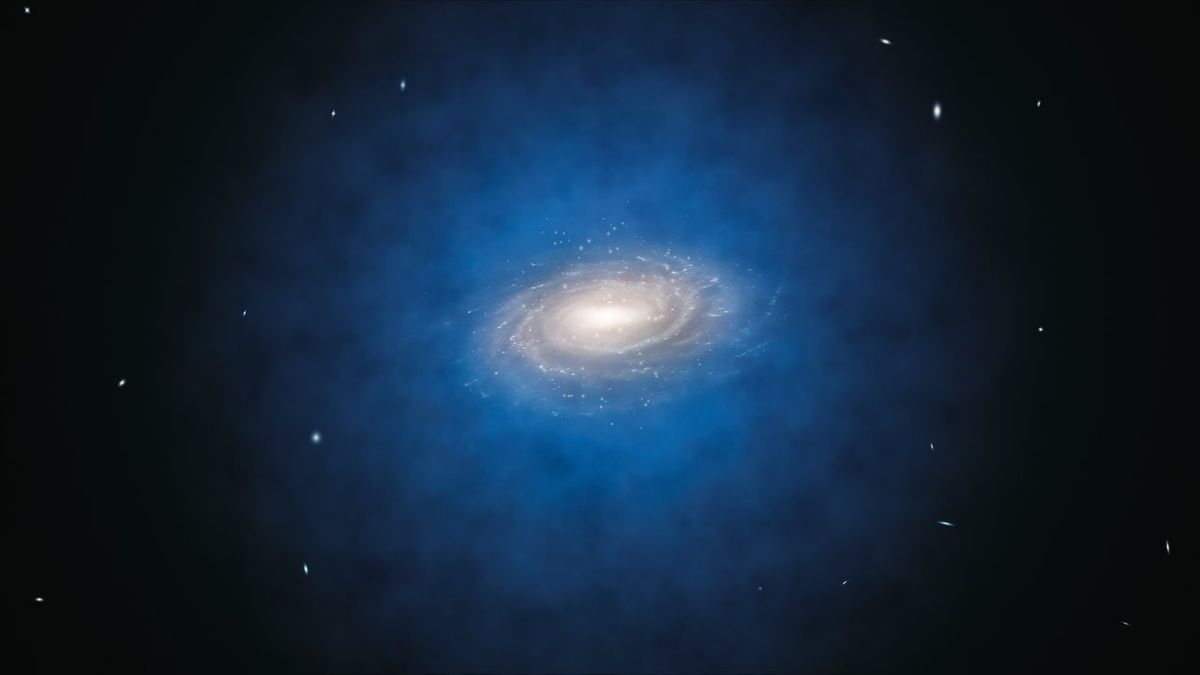A new theory that suggests dark matter is made up of particles that strongly interact with each other via a so-called “dark force.” If true, this may finally explain the extreme densities we see in dark matter haloes surrounding galaxies.
The existence of particles called self-interacting dark matter (SIDM) acts as an alternative to cold dark matter theories which suggest the elusive stuff is made up of massive, slow-moving (and thus cold), weakly interacting particles that don’t collide. The problem with those cold dark matter models is that they struggle to explain two puzzles surrounding what are known as dark matter haloes.
“The first is a high-density dark matter halo in a massive elliptical galaxy. The halo was detected through observations of strong gravitational lensing, and its density is so high that it is extremely unlikely in the prevailing cold dark matter theory,” Hai-Bo Yu, team leader and a professor of physics and astronomy at the University of California, Riverside, said in a statement.
“The second,” he continued, “is that dark matter halos of ultra-diffuse galaxies have extremely low densities, and they are difficult to explain by the cold dark matter theory.”
Related: Dark matter may be hiding in the Large Hadron Collider’s particle jets
The haloes
Dark matter presents a major conundrum for scientists because, despite making up around 85% of the matter in the cosmos, it does not interact with light and therefore remains virtually invisible to us. This tells researchers that dark matter can’t just be unseen conglomerations of matter made up of electrons, protons and neutrons — so-called baryonic matter that comprises stars, planets, our bodies and pretty much everything we see around us on a day-to-day basis. No, dark matter has to be made of something else.
The only way that researchers can infer the existence of dark matter at all, in fact, is because it has mass and thus interacts with gravity. This effect can be “felt” by baryonic matter we can indeed see and by light, which astronomers are definitely able to observe.
More specifically, when light travels past these dark matter-wrapped galaxies from background sources, the substance’s influence on the fabric of space diverts the light’s path and, in turn, makes the background sources appear “shifted” to new locations in space.
This effect, dubbed gravitational lensing, is what originally allowed scientists to determine that most, if not all, galaxies are surrounded by haloes of dark matter in the first place. And these haloes are believed to extend far beyond the limits of those galaxies’ visible matter objects like stars, gas and dust. Gravitational lensing has also allowed astronomers to measure the density of dark matter haloes. Denser haloes are responsible for stronger lensing than less dense haloes around ultra-diffuse galaxies — low-brightness galaxies with scattered gas and stars. However, researchers have struggled to explain the extremes of dark matter halo densities.
Enter, artificial intelligence
To tackle this puzzle, Yu and colleagues, including the University of Southern California postdoctoral researchers Ethan Nadler and Daneng Yang, constructed high-resolution simulations of cosmic structures that are based on actual astronomical observations.
They factored into these simulations strong dark matter self-interactions on mass scales relating to strong lensing haloes and ultra-diffuse galaxies.
“These self-interactions lead to heat transfer in the halo, which diversifies the halo density in the central regions of galaxies,” Nadler explained. “In other words, some halos have higher central densities, and others have lower central densities, compared to their cold dark matter counterparts, with details depending on the cosmic evolution history and environment of individual halos.”
The team concluded that SIDM interacting through a “dark force,” just as baryonic particles interact through the force of electromagnetism and via the strong and weak nuclear forces, could offer a solution that cold dark matter theories don’t deliver.
“Cold dark matter is challenged to explain these puzzles. SIDM is arguably the compelling candidate to reconcile the two opposite extremes,” Yang added. “Now there is an intriguing possibility that dark matter may be more complex and vibrant than we expected.”
The team thinks their research also provides an example of the analytical power of uniting real observations of the universe, which grow in detail with each new generation of telescope, with the burgeoning power of artificial intelligence.
“We hope our work encourages more studies in this promising research area,” Yu said. “It will be a particularly timely development given the expected influx of data in the near future from astronomical observatories, including the James Webb Space Telescope and upcoming Rubin Observatory.”
The team’s research was published in November in The Astrophysical Journal Letters.

Dr. Thomas Hughes is a UK-based scientist and science communicator who makes complex topics accessible to readers. His articles explore breakthroughs in various scientific disciplines, from space exploration to cutting-edge research.








